Gluten-Free Costa Rica: Everything You Need To Know
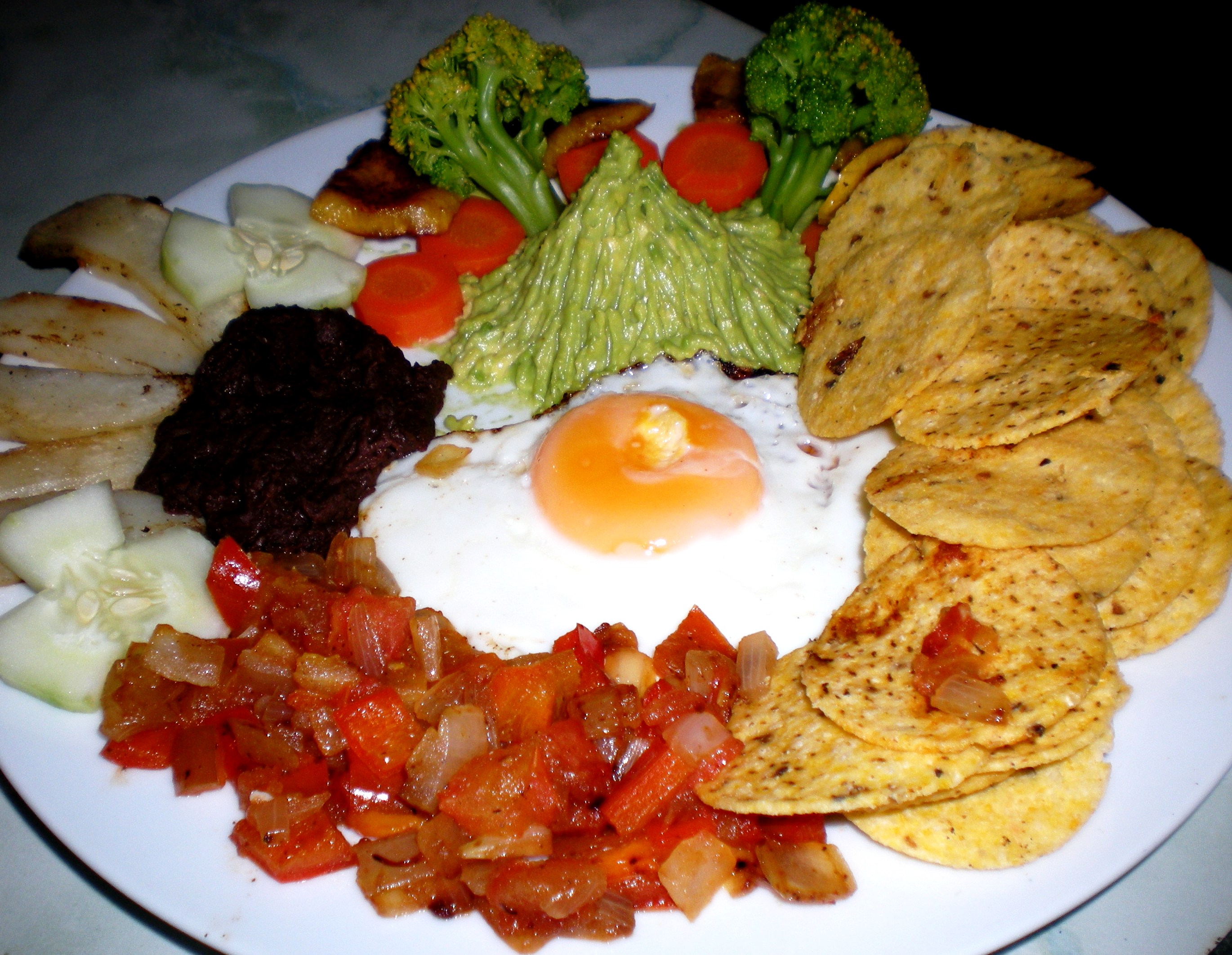
Last updated on April 2nd, 2021 at 06:18 pm GMT-6 (Costa Rica time)

Written by Nikki Solano
Nikki is the CEO of Pura Vida! eh? Inc. (Costa Rica Discounts), and the author of the guidebooks Moon Costa Rica (2019, 2021, 2023, and 2025 editions) and Moon Best of Costa Rica (2022 edition) from Moon Travel Guides. Together with her Costa Rican husband, Ricky, she operates the Costa Rica Travel Blog, created the online community DIY Costa Rica, built the Costa Rica Destination Tool, oversees the brand-new (summer 2023) Costa Rica Travel Shop, and designed the Costa Rica Trip Planning 101 E-Course. Also, Nikki wrote the Costa Rica cover feature for Wanderlust Magazine's sustainability-focused Travel Green List issue, showcased Costa Rica destinations and experiences on Rick Steves' Monday Night Travel show and podcast/radio show, and served as the Costa Rica Destination Editor for Essentialist, a luxury travel brand. Want to show your appreciation for her free article below? Thank Nikki here. ❤️️

Get the Costa Rica info you need by browsing our article's TABLE OF CONTENTS:
THE GLUTEN-FREE PHENOMENON IN COSTA RICA
Finding out you are sensitive to gluten is a bit like discovering you are a reality television fan (if you are one). You never ate a lot of wheat products to begin with (or paid much attention to the ingredients in what you did eat), just as your life never revolved around a television station’s programming schedule. You only eat toast or bagels every now and again (when you happen to be low on other breakfast items), much like you only catch a few episodes of Survivor or The Amazing Race each season (when they happen to be airing the night you planned not to work during anyway). After a while, you begin to question whether your haphazardness isn’t random. Perhaps all of the times you felt ill after eating toast and bagels may actually have something to do with the toast and bagels, and all of the free nights that conveniently opened up for relaxation (with Master Chef on the tube, for background noise) aren’t the result of good timing, rather the product of your own planned escapes. Before long it is obvious: the more you consume, the more you react. You’re missing copious amounts of school or work because you feel sick more often than you feel well, and you can’t get through an episode of The Bachelor without bawling your eyes out over who Prince Charming sent home because you are invested in the characters and affected by their emotions. It’s official, and although you may not have felt it happen, you’ve become vulnerable.
In need of a great gluten-free Costa Rica restaurant for your first or last night’s stay in San Jose? Try our recommendation for gluten-free dining at Café-Tal (a 100% gluten-free restaurant, eliminating the stress and worry of cross-contamination during food preparation).
~ Nikki & Ricky,
Costa Rica Travel Blog
Sadly, if you’re struggling with a reality television addiction we cannot offer much help (perhaps Google can). However, if you can identify with the other half of the metaphor provided above (i.e., you are either gluten-sensitive or simply prefer not to consume gluten as part of your diet) and you plan to travel to Costa Rica, you have come to the right place. 🙂
First and foremost, let’s get a few disclaimers out into the open. Gluten-sensitive travellers, just as you have likely found the same to be true in your home country, gluten-free options in Costa Rica too cannot always be guaranteed. Gluten-free marked products, found in some grocery stores and in specialty shops, can typically be trusted, but there is always the possibility of cross-contamination or human error, especially when eating at restaurants. As would be our recommendation for all gluten-sensitive individuals (regardless of whether they are dining out in their hometown or while travelling abroad), ask questions. Doing so is the best way to minimize reactions. Although mistakes can and do happen all over the world, we believe the best way to avoid miscommunication, misunderstandings, and mistakes is to obtain as much information as you can from the people responsible for preparing the food. If you ever doubt which products were used or which processes were undertaken throughout a meal’s preparation you can always opt to dine elsewhere. For the purpose of our recommendations below, each assumes that no act of cross-contamination or human error took place. In addition, there is ambiguity in gluten-free discourse regarding non-wheat forms of gluten, specifically corn gluten. Since the majority of gluten-free research focuses on gliadin (the form of gluten found in wheat), most gluten-free talk is essentially gliadin-free talk (or wheat-gluten-free talk), and therefore does not specifically address corn gluten (or other types of gluten). For the purpose of our recommendations below, each assume that “gluten-free” denotes the absence of gliadin, mirroring the state of common discussion and excluding other gluten types. This being said, we know that just as some individuals easily react to wheat-gluten, some of those individuals and others may react to other forms of gluten including corn gluten. For this reason, we do not aim to suggest that the food types and food preparation recommendations discussed below will eliminate all reactions in all travellers; food sensitivities are as complex, unique, and tricky to deconstruct as the individuals who have them.
As we touch on in our related blog post: Vegetarian And Vegan Dining In Costa Rica, Costa Rican cuisine can quite easily accommodate a vegetarian diet, whereas vegan diets face a number of challenges (some of the information provided in our vegetarian/vegan blog post has been repeated below as it can also be applied to a gluten-free diet). Gluten-free Costa Rica falls somewhere in the middle; gluten-free Costa Rica meals are less common finds than vegetarian ones, but they are not as tricky to ensure as vegan choices given the multitude of ingredients that are no-no’s on a vegan food list. If you are a gluten-sensitive traveller planning to visit Costa Rica, here’s what you need to know.

GLUTEN-FREE COSTA RICA: DINING OUT
In general (for all diners, including gluten-sensitive ones), Costa Rican food is simple and repetitive. The majority of restaurants offer the same staple dishes, with the exception restaurants that cater to worldly cuisines, including American and European tastes. If you have travelled to Costa Rica before, you have likely already tried the country’s two most well-known staple dishes (time and time again!) and you know that rice and beans are present in both. Prepared as a rice and beans medley in the morning (called “Gallo Pinto”) and served separately on the plate during lunch and dinner (called “Casado”), Costa Ricans are accustomed to consuming rice grains and bean protein at multiple times throughout the day. If you are a fan of rice and beans (either served together or separately), you’re in luck. You will be able to access these gluten-free Costa Rica food choices (provided they are served in their natural state) at any local restaurant in the country, and at any time of the day.
Managing a trip to Manuel Antonio? Try our recommendations for gluten-free Costa Rica dining at Café Milagro (relaxed atmosphere, offering gluten-free menu items with reasonable prices) or Arenas Del Mar (resort-quality, luxurious dining with like-minded prices)
~ Nikki & Ricky,
Costa Rica Travel Blog
Morning meals should not be feared by gluten-sensitive travellers. Gallo pinto is a perfectly gluten-free Costa Rica meal that is typically prepared with oil, salt, cilantro, and a hint of Costa Rica’s own Salsa Lizano (prepared with water, sugar, salt, onions, carrots, cauliflower, cucumbers, spices, pepper, mustard, and turmeric; Salsa Lizano is wonderfully gluten-free!). Not only delicious, the meal is jam-packed with the protein and energy travellers need to explore the country’s inviting, yet rugged, terrain. When ordering, question what the restaurant or hotel will serve as a side dish. Gallo pinto is sometimes served with a side of eggs (appropriate for gluten-sensitive travellers), toast (skip this choice, unless a gluten-free bread option can be provided), a tortilla (a safe choice if the tortilla is a corn one without any wheat products added, otherwise an unsafe option if made from wheat), or a bowl of fresh fruit. For lunch and dinner, try casado (most often ordered alongside a helping of either chicken, beef, pork, fish, or vegetables; see our cautionary note in the sample meal plan provided below regarding stuffed and/or breaded meat/fish). If you’ve had your fill of beans from your morning gallo pinto, order a meat dish on its own (without the rice and beans) or one of a variety of rice dish options typically listed on menus as “rice with ‘X’”. Similar to casado dishes but without the beans, “rice with ‘X'” diners can select either chicken, beef, pork, fish, or vegetables to be cut up and mixed in with rice; the end product closely resembles oriental fried rice. Similar to our gallo pinto side dish warning noted above, ask what the restaurant or hotel will serve as the entree’s side. This is sometimes a garden salad (which may or may not be gluten-free, depending on the salad’s contents and dressing) or a potato or yucca puree (either of which would be gluten-free on their own, provided neither is prepared with non-gluten-free ingredients added in). If you explain to the restaurant staff that you are sensitive to gluten, they should be able to substitute any non-gluten-free side dish for half an avocado, additional vegetables, or another appropriate alternative.
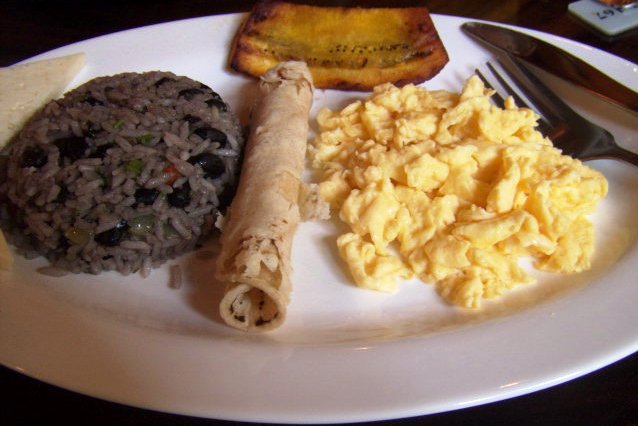
Driving yourselves to or from La Fortuna (Arenal) via San Ramon (Alajuela/San Jose)? Try our recommendation for gluten-free Costa Rica dining at Lands In Love (a hotel and restaurant unlike any other, offering vegetarian, vegan, and gluten-free cuisine).
~ Nikki & Ricky,
Costa Rica Travel Blog
When Ricky and I dine out (given that we are vegetarians and not gluten-free individuals), we tend to stick to the basics and order rice with vegetables or “Casado Vegetariano” (vegetarian casado). If all else fails, or we are in the mood for something different, we order a vegetarian pizza. If need be (if a vegetarian pizza option is not included on the menu), we ask for a pizza to be prepared without meat. Of course, we can appreciate that pizza would not be a suitable go-to menu option for gluten-sensitive travellers given its wheat crust, unless a restaurant’s chef opts to make his or her own dough using one of a variety of gluten-free flours. If you follow our recommendation to ask questions and challenge a chef with the following: “Which flour(s) was/were used to prepare the pizza dough?“, the following are gluten-free flour types to hope for in his or her answer (listed in alphabetical order): amaranth, arrowroot, banana, brown rice, buckwheat, chia, chick pea/garbanzo, coconut, coffee, corn, cornmeal, hemp, millet, potato, quinoa, rye, soya, tapioca, teff and white rice. These flours can also be used to prepare gluten-free breads, pastries, and desserts, so locating restaurants and bakeries that use them are key to your gluten-free dining success. On the other hand, if a menu or chef disclose that any of the following flours have been used to produce the food you are about to eat, the end result will not be gluten-free: bulgar, brown, durum, graham, kamut, semolina, spelt, wheat, and wholemeal. For travellers who are not yet aware, the most common pasta type sold in Costa Rica (and in most countries in the world) contains gluten as it is made with durum wheat flour and/or semolina. Unfortunately, this means that eating pasta in Costa Rica should be limited to sites that can confirm their pasta is of a gluten-free variety (such as rice pasta).
GLUTEN-FREE COSTA RICA: GENERAL TIPS
Fresh fruit is always a good choice
It is local, delicious, and 100% gluten-free. Why not try some watermelon? It is a fantastic source of iron. Fresh fruit also makes for some great juice smoothies. My favourite is a slushy fruit smoothy made with water. Ricky’s favourite is a creamy concoction comprised of fruit and milk.
Nuts and seeds are a great snacks for an energy boost given their high protein, zinc, and omega-3 fat content
Unfortunately, although nuts (including peanut butter) and seeds are readily available at Costa Rican supermarkets, they are also incredibly expensive. Make sure to read the labels on all purchased products, as some nut and seed mixes are not gluten-free given extra ingredients added to the blends or their passage through a non-gluten-free facility. Assuming the products are purchased raw (unflavoured), on their own (unmixed), and processed in a gluten-free facility, the following are a list of great gluten-free nut and seed choices (in alphabetical order): almond, brazil, cashew, chestnut, coconut, chia, flax, hazelnut, macadamia, peanut, pecan, pine, pistachio, pumpkin, sesame, soy, sunflower, and walnut.
Munch on raw vegetables
Consider picking up carrots, broccoli (great for calcium!), cauliflower, and other vegetables at a local supermarket to break into small pieces for snacking on at your hotel or during city-to-city transportation services. Hummus makes a great gluten-free vegetable dip, so long as it is prepared with its typical ingredients: chickpeas/garbanzo beans, tahini, olive oil, lemon, and salt.
Avoid purchasing whole grain products at grocery stores unless they are specifically marked gluten-free
Although the gluten-free tide has rolled in on many countries worldwide, gluten-free products are not yet the norm in Costa Rica (health stores excluded). Most breads, pastries, cakes, crackers, cookies, cereals, noodles, pastas, and white tortillas that line store shelves do so in their original wheat-filled state. This makes it difficult for gluten-sensitive travellers to rely solely on the local “super” to accommodate their gluten-free shopping list.
Be prepared to not only explain that you are sensitive to gluten but to go one step further and explain what this means in detail
Declaring upfront what you will and will not eat is always best. Not everyone, including restaurant and hotel staff, is yet familiar with the terminology, concept, and rules of the gluten-free diet.
If you plan to visit a popular area of Costa Rica, seek out gluten-free restaurants in advance
The country is not booming with gluten-free Costa Rica restaurants but they do exist. Although gluten-free menu options are not yet offered by all restaurants, there are specialty restaurants and hotels that cater to specific dietary choices. For some example, see the block quotations provided throughout this post.
Gluten-free Costa Rica breakfast
- Gallo Pinto (rice and beans mix)
- Fresh Fruit
- Eggs
- Yogurt (only if free of gluten-containing ingredients)
- Pancakes/French Toast/Waffles/Pastries/Breads (only if prepared with a gluten-free flour, such as one of the varieties listed above)
gluten-free Costa Rica lunch or dinner
- Fresh Vegetables (such as asparagus, broccoli, cabbage, cauliflower, celery, garlic, green beans, kale, lettuce, mushrooms, onions, and spinach, as well as fruits most tend to erroneously associate with vegetables: avocado, bell peppers, cucumber, eggplant, tomato, and zucchini)
- Casado (rice and beans, served separately on the plate) with chicken, beef, pork, fish, or vegetables (assuming the meat/fish has not been processed with wheat products, as is sometimes the case with stuffed and/or breaded meat/fish)
- Rice with chicken, beef, pork, fish, or vegetables (assuming the meat/fish has not been processed with wheat products, as is sometimes the case with stuffed and/or breaded meat/fish)
- A chicken, beef, pork, fish, or vegetable dish prepared on its own (assuming the meat/fish has not been processed with wheat products, as is sometimes the case with stuffed and/or breaded meat/fish)
- Sandwiches/Hamburgers (assuming the meat/fish has not been processed with wheat products, as is sometimes the case with stuffed and/or breaded meat/fish, AND assuming the bread/buns are prepared with gluten free flour, such as one of those listed above)
- Salad (only if prepared with gluten-free ingredients and a gluten-free dressing)
- Pizza (only if the dough is prepared with a gluten-free flour, such as one of the varieties listed above)
- Pasta (only if the pasta is prepared with a gluten-free flour, such as one of the varieties listed above)
- Ceviche (fish soup)
- Patacones (flattened, fried plantain)
Gluten-free Costa Rica dessert
- Fried Plantain
- Arroz con Leche / Rice Pudding (assuming the dessert follows standard recipes that do not typically call for the use of gluten-containing ingredients)
- Tres Leches / Three Milk Cake (only if prepared with gluten-free flour, such as one of the varieties listed above)
- Flan de Coco / Coconut Flan (assuming the dessert follows standard recipes that do not typically call for the use of gluten-containing ingredients)
- Ice Cream in a bowl (without the cone and only if prepared with gluten-free ingredients, noting that wheat stabilizers sometimes found in ice cream contain gluten)
- Jello
Gluten-free Costa rica beverages
- Standard Beverages such as Water, Sodas, and Coffee with or without Milk/Cream
- Fresh Fruit Juice/Smoothies made with Water or Milk
- Fresh Pipa
- Alcohol, with the exception of Beer (Malt), Rye, and/or other gluten-containing spirits/cocktails
Our gluten-free Costa Rica “cautious” list (the following may not cause a reaction, but why take the chance?)
- Granola. Unless you are 100% sure of the entirety of its contents, granola boarders on being a red flag given the possibility that the oats or other inclusions may contain gluten or may have been produced in a facility containing gluten.
- Soup. Unless you are 100% sure the soup has not been thickened by a wheat-containing source.
- Add-ons, including gravy, sauces, syrup, ketchup, and mayonnaise. Not all of these add-ons will cause a reaction, but why risk the enjoyment of a perfectly good gluten-free meal for a dash or splash of an add-on that you are not 100% sure about?
- Bread/dough-based bakery items. Unless any item is certified gluten-free.
- Tortillas (soft or hardened; served as chips). While corn tortillas are gluten-free (assuming wheat products have not been added in), wheat ones are not. If you are unsure how to decipher the difference for yourself, or if the restaurant/hotel staff is unsure which type of tortillas they are, perhaps they are not worth the risk.

GLUTEN-FREE COSTA RICA: PLAYING HIDE AND SEEK
Planning to visit Tamarindo? Head to the website Gluten Free Tamarindo before your visit. Specifically, check out their list of awesome gluten-free Costa Rica restaurants, cafes, bars, and other establishments, all in the Tamarindo area!
~ Nikki & Ricky,
Costa Rica Travel Blog
Let’s say you are dining out and you ask your water or waitress if a particular menu item contains gluten. After smiling, shrugging off the look of utter confusion they give you, and waiting patiently for a few minutes, you are greeted once again by the employee who hands over a piece of packaging for you to review for yourself. The word “gluten” is nowhere to be seen, but if your sensitivity is a great one (as you have had the physical inconvenience of learning firsthand), you know that the protein is a sneaky little pest that can hide in a variety of sources. To help you win at this game of hide and seek, take note of the following text (provided by gicare.com). If you spot any of the the below items on the package’s ingredient list, it could contain gluten:
- Hydrolyzed Vegetable Protein (HVP), unless made from soy or corn
- Flour or Cereal products, unless made with pure rice flour, corn flour, potato flour or soy flour
- Vegetable Protein, unless made from soy or corn
- Malt or Malt Flavoring, unless derived from corn
- Modified Starch or Modified Food Starch, unless arrowroot, corn, potato, tapioca, waxy maize or maize is used
- Vegetable Gum, unless made from carob bean, locust bean, cellulose, guar, gum arabic, gum aracia, gum tragacanth, xantham or vegetable starch
- Soy Sauce or Soy Sauce Solids, unless you know they do not contain wheat
Looking for an all-in Costa Rica retreat that is 100% gluten-free? Choose the Anamaya Resort; Chef Jeff will amaze you with his abundance of meal options catering to gluten-free travellers (in addition to vegetarian travellers, vegan travellers, and/or dairy-free travellers).
~ Nikki & Ricky,
Costa Rica Travel Blog
In addition, gicare.com indicates that the words “stabilizer, starch, flavoring, emulsifier, hydrolyzed, and plant protein” mean that a grain containing gluten has been used.
COMMUNICATING YOUR GLUTEN-FREE DIETARY RESTRICTION(S) IN COSTA RICA
To best assist you throughout your Costa Rica dining escapades, use the following English to Spanish guide to help you discuss menu options with restaurant and/or hotel staff if their English is limited:
- I am sensitive to gluten -> Soy sensible al gluten
- I am allergic to gluten -> Soy alérgico/a al gluten
- I eat gluten-free -> Yo como libre de gluten
- I do not eat gluten -> Yo no como gluten
- I do not eat foods containing gluten -> Yo no como comidas que contienen gluten
- Is there gluten? -> ¿Hay gluten?
- Is there wheat? -> ¿Hay trigo?
- What type of flour was used? -> ¿Qué tipo de harina se utilizó?
- What ingredients does this include? -> ¿Qué ingredientes contiene este?
- May I see the ingredient list? -> ¿Puedo ver la lista de ingredientes?
Have another phrase that you need help translating? No problem! Leave a comment for us below and we can translate your desired words/phrases for you.
QUESTION TO COMMENT ON: What are your biggest concerns/challenges when travelling on a gluten-free diet?
Pura vida!

Hey, Costa Rica Travel Blog reader, thank you for visiting and reading our blog! We're truly grateful for your time and preference.
Do you know that your spam-free reading experience is most important to us? Unlike some other Costa Rica blogs, we do not to sell your personal information, and we choose not to display ads, sponsored content, or affiliate marketing on our blog so we can keep your visit as distraction- and junk-free as possible. Because we prioritize your privacy, we don't earn money when you visit us, when you sign up for our e-course, or when you click on our links, which means the time and work we put into this blog—including its 300+ articles—is entirely voluntary! If you find our content valuable, and you'd like to thank us for making the trip-planning process easier and your Costa Rica vacation more enjoyable, please consider making a small donation ($1, $2, $3, or an amount of your choosing) to our blog. Doing so is a great way to pat us on the back if you feel we deserve it. 😊 Pura vida, amigos!
Click on the button above to donate through PayPal. (If you cannot see the PayPal button above, click here.) A PayPal account is not required to make a donation; credit and debit cards are also accepted. PayPal donations are confidential; we never see your payment details.
Love our blog? Check out our other Costa Rica-related projects, too:

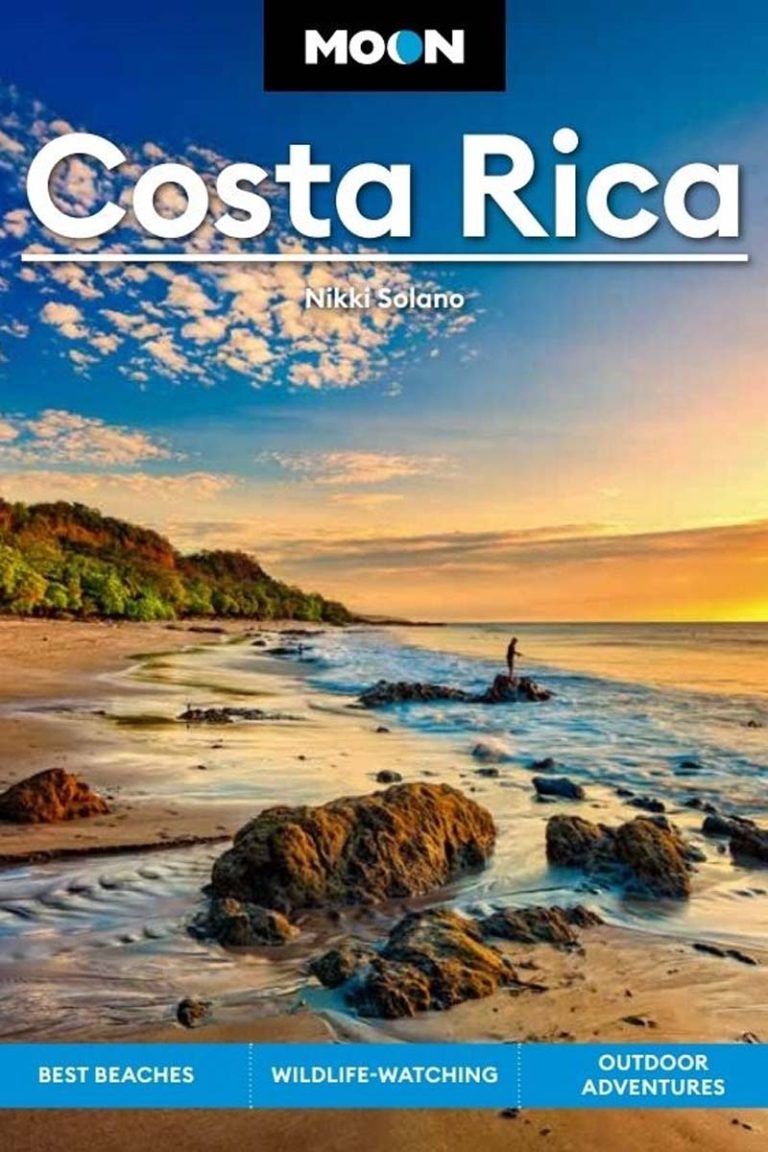
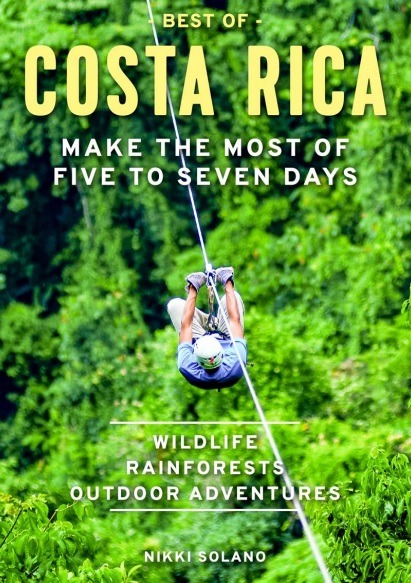

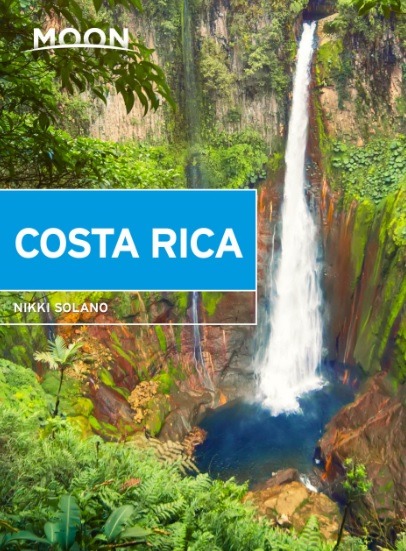











Tagged: costa rica, costa rica travel, costa rica travel tips, cuisine, diet, dining, food, gluten, gluten-free, travel, travel guide, travel tips, vacation